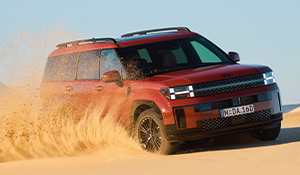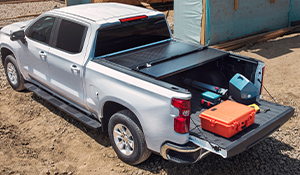2018 Toyota Prado VX
What is the 2018 Toyota Prado VX?
The Prado is Toyota’s big seven-seat family 4x4 wagon for those who don’t want – or can’t afford – the full-size LandCruiser 200 offering. There are four trim levels and the well-appointed Prado VX sits one rung below the top-spec Kakadu.
The Prado is the best-selling large-4x4 wagon by a long shot, racking up a healthy 15,627 sales so far in 2018 (to the end of October). Sure, HiLux and Ranger 4x4 utes have cracked more than 30,000 sales in the same period, but the only large wagon with genuine off-road capability that comes close to Prado in the sales stakes is Toyota’s own 200 Series LandCruiser with 11,562 sales.
At almost five-metres long the Prado is a big wagon, but it’s still around 300-400mm shorter than the current crop of dual-cab utes that dominate the 4x4 scene and, as such, it’s more manoeuvrable and easier to live with day-to-day in an urban environment, with its 11.6m turning circle comparing favourably with most utes on the market.
while it might not have the load capacity of a ute, its seating for seven still finds favour with families who have plenty of kids (and their mates) to lug around after school and on the weekends.
The Prado is a traditional 4x4 wagon in that it has separate body-on-chassis construction, with independent double-wishbone/coil-strut suspension up front and a four-link live-axle set-up at the rear with coil springs. It is powered by a 2.8-litre four-cylinder common-rail injection turbo-diesel engine that’s mated to a six-speed automatic transmission and a two-speed transfer case. The Prado runs a full-time 4x4 system with a lockable centre differential, electronic traction control and a lockable rear differential.

Standard exterior equipment on the auto-only Prado VX includes 18-inch alloy wheels running 265/60R18 tyres with a full-size tailgate-mounted spare, Auto-Levelling Bi-LED headlamps with LED DRLs, LED fog lamps, heated mirrors, privacy glass and roof rails.
The interior of the VX grade is well appointed with leather seat trim, power adjustable, heated and ventilated front seats, heated second-row outer seats, 40:20:40 split fold second-row seats, 50:50 split fold third-row seats, keyless entry and start, three-zone climate control air conditioning, refrigerated centre console bin, 4.2-inch multi-information display, 8-inch colour touchscreen, 14-speaker JBL sound system with Bluetooth connectivity, CD player and digital radio (DAB), satnav and Panoramic and Multi-Terrain Monitor.
What’s the interior like?
The Prado’s dash design is improved over the previous model but the centre section that houses the air vents, the 8-inch touchscreen and HVAC controls is still quite boxy.
The angle of the touchscreen itself can catch the sunlight and reflect it back towards the driver, making it difficult to see. Nevertheless, there are big, clearly labelled switches and knobs for all functions, and it doesn’t take long to become familiar with the location of controls.
The lower part of the dash houses a handy storage bin and is the location for controls including ‘H4’ and ‘L4’ selection, the centre and rear diff locks, stability control on/off and Hill Descent Control.
The centre console has a couple of cup holders under a pop-up lid, but of you have bottles in them the aforementioned 4x4 controls will be obscured. Controls for the heated and ventilated front seats are just in front of the spacious and cooled centre console bin, as is a 12V outlet and USB/Auxiliary connections.
The instrument binnacle is a big step up with its 4.2-inch colour multi-information display, flanked by analogue speedo, tacho, water temperature and fuel-level gauges.
The trip computer is easy to use and offers a wealth of information, and there are steering wheel buttons to adjust the Active Cruise Control distance, set Lane Departure Alert, operate Bluetooth phone connectivity and more.
The front seats are comfortable and there’s plenty of adjustment for driver and passenger alike, with ample leg room. Driver’s seat height adjustment provides a good over-bonnet view, even for shorties.

The second-row seat offers good leg room thanks to fore/aft adjustment, and there’s also backrest rake adjustment. The three-way split/fold adds to versatility and while you can fit three adults across the second row it’s more comfortable with just two in there. There’s also a fold-down centre armrest with built-in cupholders. Those in the back also have access to their own HVAC controls
Access to the third-row is good thanks to the sliding second row, and while kids will be happy enough in the very back, adults only have enough space for very short trips.
The cargo space is small when all three rows of seats are in use, but there’s generous space with the third row folded into the floor. Of course, this increases further with the second-row seats folded too, but the load floor is not compleltly flat, with gaps that small items are likely to fall into. There’s a handy 220V power outlet in the cargo area and good lighting, as well as roof-mounted air vents for all three rows.
Access to the cargo area is excellent thanks to the large, swing-out tailgate, which can be locked open by twisting a strut. There’s also the option of a flat tailgate with a pop-up window that sees the spare tyre relocated to beneath the vehicle. This option, however, means the 63L sub-tank is deleted, reducing fuel capacity from a class-leading 150L down to an average 87L.
What’s it like on the road?
Weighing in at a portly 2385kg, and with only modest peak output from its 2.8-litre four-cylinder turbo-diesel engine, on-road performance is best described as adequate rather than outstanding.
Sure, there’s reasonable response from low in the rev range, and the six-speed automatic offers smooth enough shifts, but there’s not a lot up top, which means you have to leave yourself plenty of space when overtaking.

Overall gearing in fifth and sixth gears is very tall, most likely in an effort to improve fuel economy, and the Prado’s auto will often stick to fifth gear instead of sixth if there’s a hint of a headwind or a slight uphill grade. But the engine itself is refined, and the Prado offers great NVH control on the highway.
The Adaptive Cruise Control works well on the freeway, maintain a user-selectable distance to the vehicle in front, or it can be disabled, leaving you with a traditional cruise control. The lane-departure warning can also be switched off, which is handy when driving on winding backroads where you might intentionally cross road markings.
Ride quality is impressive over a variety of road surfaces and the Prado’s soft suspension does an admirable job of soaking up bumps and other road surface irregularities, but body roll when cornering can feel quite pronounced and the hydraulically assisted power steering doesn’t offer great feel or feedback through the wheel.
For those with the budget to upgrade, the top-spec Prado Kakadu model is equipped with Toyota’s Kinetic Dynamic Suspension System (KDSS), which offers much better control of body roll, albeit at the expense of some ride comfort.
Thanks to the Prado’s full-time 4x4 system, there’s always plenty of traction on slippery surfaces such as wet bitumen or gravel, and locking the centre diff is easily achieved via a button on the centre console.

What’s it like off the road?
The Prado is a strong off-road performer with reasonable off-road angles, good ground clearance, impressive rear wheel travel, reasonable front wheel travel and good low-range reduction
It’s also armed with a fair amount of high-tech off-road armour such as Hill Descent Control, electronic traction control and a rear diff lock. On the downside, the traction control is disabled when the rear diff lock is engaged, and on some undulating climbs on test the Prado worked best with the rear diff unlocked.
Wading depth is a claimed 700mm and Toyota offers a genuine-accessory snorkel for those who want to tackle water crossings. In fact, there’s a long list of OE accessories including bull bars and the like, and the 4x4 aftermarket industry caters to Prado owners with just about everything you could imagine, from protection equipment, suspension, front diff locks, wheel carriers, roof racks and more.
What safety features does it get?
The Prado was awarded a five-star ANCAP rating in 2013. Standard safety equipment includes ABS, electronic traction control, Vehicle Stability Control, Trailer Sway Control,
Electronic Brake-force Distribution (EBD) and Brake Assist (BA), Toyota Safety Sense (Lane Departure Alert, Pre-Collision Safety System with pedestrian detection, Automatic High Beam and Active Cruise Control), Blind Spot Monitor, Rear Cross Traffic Alert and front and rear parking sensors. There are two ISOFIX anchor points in the second row and the Prado scores seven SRS air bags.

So, what do we think of the 2018 Toyota Prado VX?
The Prado VX is a genuine all-rounder that feels just at home performing the weekday school-run as it does driving to the bush on an extended outback adventure. It’s comfortable, well-appointed and capable, but a lack on-road performance and too-soft suspension lets it down somewhat.
While Toyota offers an unrivalled sales and service network in Australia, the Prado’s three-year/100,000km warranty and short six-month/10,000km service intervals aren’t a match for many competitors.
Rating
What’s the interior like? 3.5/5
What’s it like on the road? 3.5/5
What about safety features? 4/5
Practical Motoring Says: The Prado VX is a well-appointed family 4x4 wagon with genuine off-road capability that’s well catered to by the 4x4 aftermarket.
Pricing $73,619 Warranty 3-years/100,000km Service Intervals 6 months/10,000km Safety 5 star ANCAP (2013) Engine 2.8-litre four-cylinder turbo-diesel Power 130kW at 3400rpm Torque 450Nm at 1600-2400rpm Transmission 6-speed automatic Drive full-time 4WD Dimensions 4995mm (L); 1885mm (W); 1890mm (H) Turning Circle 11.6m Ground Clearance 219mm Wading depth 700mm Kerb Weight 2385kg GVM 2990kg Payload 605kg Towing Capacity 750kg/3000kg Tyres 265/60R18 Spare Full-size Fuel Tank 150L Thirst 8.0L/100km (combined)










